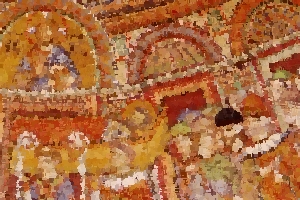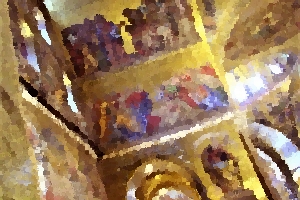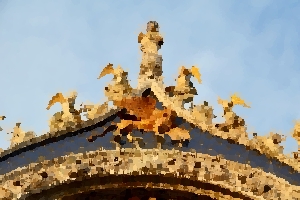Impressive mosaics
 Part of a mosaic in Basilica San di Marco in Venice. [Report image]
Part of a mosaic in Basilica San di Marco in Venice. [Report image]While the building's structure has not changed substantially in the intervening years, its interior's adornment has altered over the years. Each succeeding artistic period saw new decorative elements added, with new columns, marbles, and carvings added to the interior and the exterior.
The interior walls are covered with Byzantine and Gothic mosaics. The floor, added in the twelfth century, is a geometrically-designed mixture of marble and mosaics inlaid with gold and bronze, with animal designs interspersed within the patterns.
 Mosaics inside the Basilica San di Marco - By Ron Gatepain
Mosaics inside the Basilica San di Marco - By Ron GatepainThis richly-decorated floor covers more than 2000 square meters, and altogether, the interior walls and floor of the basilica are covered by more than 8000 square meters of mosaics created between the eleventh and nineteenth centuries. The narthex, or entrance, of the church, displays scenes from the Old Testament. Within the basilica itself, scenes from the New Testament are the predominant theme. These mosaics depict events in the lives of Saint Mark and other saints, Christ and the Virgin Mary.
The construction of mosaics initially began in 1071 and has continued off and on for several centuries. In the thirteenth century, many marble sculptures and works of art were transported to the basilica after Constantinople had been conquered during the Fourth Crusade. These include relics, crosses, chalices, and icons today held in the Treasury of the basilica. Further statuary was added during the fourteenth century. The building's exterior was redecorated in the Gothic style in the late fourteenth and early fifteenth centuries with the addition of spires and sculptures of saints and angels.
Sculptures and ornaments
 The ornament at the top of St. Mark's Basilica in Venice. [Report image]
The ornament at the top of St. Mark's Basilica in Venice. [Report image]The basilica is also rich in sculptural art, some created expressly for the church itself, and some obtained elsewhere and placed within the church. These include altars, columns, and statues, made of bronze, marble, and oriental alabaster, representing Biblical figures and events in their lives.
Even though the basilica displays decorative elements from an eclectic range of locations and historical periods, the result is remarkably cohesive and well-structured—the Basilica di San Marco is simply a beautiful building both inside and out.
The Museum
St. Mark's Museum, situated above the north-west atrium of the basilica, was established towards the end of the nineteenth century. The museum contains various exhibits, including Persian carpets, paintings, illuminated manuscripts, tapestries, and ancient mosaics. One of the most interesting pieces is the quadriga of St. Mark's, a statue of a four-horse chariot that once adorned the building's façade. The quadriga was re-housed in the museum during the last restoration of the basilica.